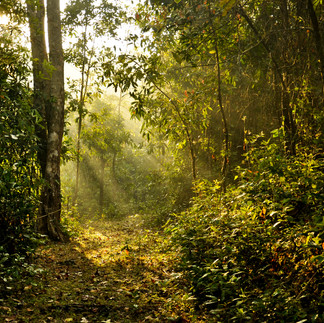European forest microclimates mapped at high resolution - new paper out!
- kristofferhylander
- Oct 4, 2021
- 2 min read
A new paper, published in Global Change Biology and co-authored by our lab, provides novel high-resolution Europe-wide maps for monthly sub-canopy temperatures. These maps are very valuable for ecological modelling and research on climate change impacts on biodiversity. The study utilized a newly established global microclimate database (SoilTemp), for which new contributions are always welcome.
Climate dictates various processes and patterns of our biosphere. Thus climate maps are a crucial component of ecological research. However, those maps are based on weatherstation data, where temperature is measured at 1.5 – 2.0 m height above a flat open short-vegetated surface. Under forest canopies, temperatures can differ strongly from the ambient air temperatures outside forests that weather stations measure.
The newly published European maps provide monthly temperature offsets, i.e. the difference between sub-canopy temperatures inside the forest and ambient air temperatures outside the forest. The new forest microclimate maps come also with a much higher resolution compared to classic climate maps (25 m vs. 1-30 km). The high resolution allowed the research team to account for differences in the terrain and canopy cover, which can cause significant temperature differences over short distances.
How was this possible?
The maps were created with the help of thousands of tiny ”weatherstations” inside the forest, so-called temperature loggers. There are many different logger types now on the market, but one of the most popular ones is the TMS-4 logger, which mimics a small plant, and measures near-surface temperature belowground in the soil, at the surface and above ground in the air.
Many enthusiasitic researchers have put out these small loggers around the globe measuring microclimate within the scope of their own projects. It was only a natural next step to start a global database, compiling all these microclimate datasets together and making them available for continent-wide or global analyses. Jonas Lembrechts – a PostDoc from Antwerp University, Belgium - was the visionare, who actually made this happen.
Thanks to his effort and thousands of data contributions from all over the world, we can now empirically study global patterns and drivers of near-ground temperatures and how they impact ecological processes and patterns, like for example species distributions and range shifts, population dynamics, buffering of drought events.
This particluar study, which uses a subset of the SoilTemp database with data from European forests, was lead by Stef Haesen from the sGLOBE lab of KU Leuven, Belgium, and can be found here.
Contribute to the global microclimate database!
If you have have local temperature data (and maybe even associated species data), consider contributing to the SoilTemp database. This will not only give your research data a ”second life” and high chance to be re-used for future studies, it will also link you to a growing international network of microclimate ecologist and will provide you with opportunities to co-author exciting papers using the database.
You find the official call for data contribution here.








Comments